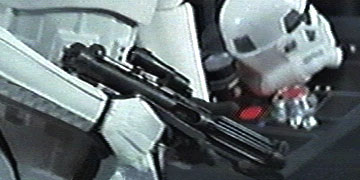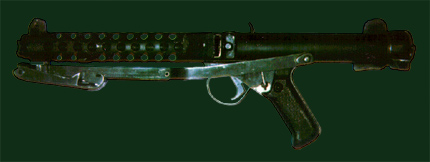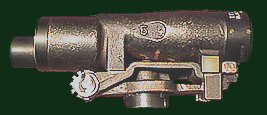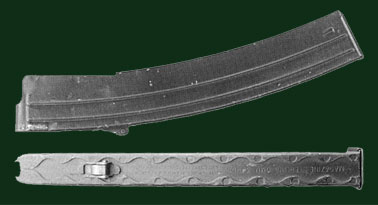EPISODE IV: A NEW HOPE
Used by:
Han Solo
Stormtroopers

Version C

The BlasTech E-11's were built from British Sterling Mk4/L2A3 submachine guns. Produced after 1957, they may have been UK military contract weapons.

Sterling Arms Mk4/L2A3 Submachine Gun
Modifications to the guns involved the addition of six grips around the barrel. The exact identity of the grip material has yet to be determined, but recent revelations suggest hard black plastic T-track from old cupboards with sliding doors. These were cut to varying lengths and each end was then inserted into the appropriate cooling hole in the barrel jacket. Note: The row of holes on the underside of the gun had no grips as they would interfere with the folding stock. Also, the row of holes just above the folding stock on the left side of the gun received no grips, presumably this is because of the bayonet attachment stub that occupies the third hole from the front in this row.
Another modification includes the addition of a stock 1942 model M38 azimuth scope (see below) to a mount. This scope mount is in the form of an approximately 1cm wide by 1/16" - 1/8" thick strip of metal sitting about a 1/4" above the gun. The front end of the strip was bent and inserted into the rear most vent hole on the top of the gun thus requiring no rivet or other attachment. On this blaster variation the rear of the mount strip goes straight back into the rear sight and is attached there presumably by riveting it to the sight.

1942 model M38
Two small cylinders (details on these are not known) rest on top of the magazine well in a mount of sorts. See the "Unidentified" section of the site for detailed photos and theories about these parts.
The standard Sterling Mk4/L2A3 34-round magazine model L1A1 was used. These were manufactured by Sterling Engineering Co of Dagenham, Essex. The unique scalloped-edge design (seen below) distinquishes it from magazines made by other military contract manufacturers.

34-round Sterling L1A1 Magazine
Made by Sterling Engineering Co.
They were cut down considerably. The exact length varies between each prop (from 1/2 to 2/5 the original length). Both ends of the magazines were used. The blank firing versions, like this one, used the feed end of the magazine which locks into the magazine well while non-firing models usually used the left over ends. On some of the guns there are magazines with the real bottom plate covering the exposed end. Others have replicated plates (no hole in the center) and some were just plugged with a piece of wood.
Also of note is that this version unlike some of the others still has the bolt cocking lever. This is still here because of the functional nature of the weapon....After all you have to cock it to fire it even if they are only blanks. In the picture at the top of this page the bolt is cocked and not visable through the cartridge ejection port on the gun as it would be if it were forward.
Want to know more? Check out the ANH E-11 Variation Quick Reference Guide for more versions of the E-11